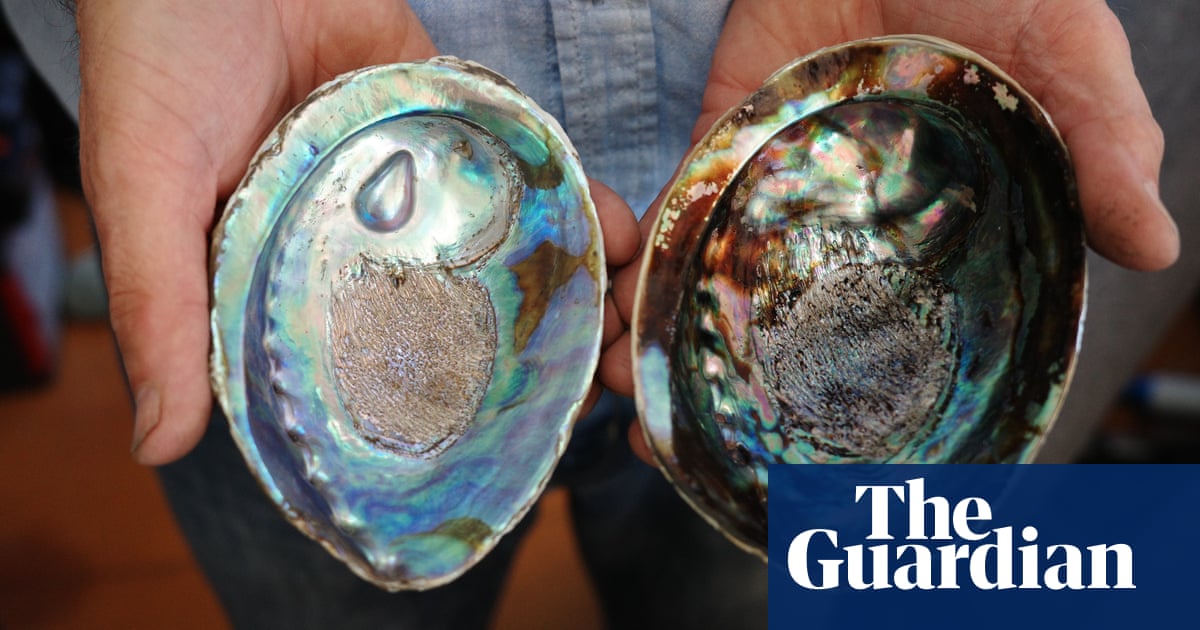Roger Beattie was diving off the Chatham Islands, about 800km east ofNew Zealand, when he saw his first pāua pearl. Beattie was familiar with pāua, the Māori word for abalone, and their iridescent shells of shimmering purples and greens. But the pearl that had formed inside was unlike anything he had ever seen, gleaming with layers of the pāua’s natural colours.
“I just thought ‘heck, that would make amazing jewellery,’” Beattie says.
That was in the early 1990s, and Beattiesoon started experimenting ways of farming pāua, and creating pearls in the shell. A decade later, he began selling the so-called blue pearls commercially.
Now, a small industry exists in New Zealand cultivating the unique gems. They are rare, with only a handful of companies running farms, each producing only a few thousand pāua pearls each year. But the delicate operations are being made more complicated as changing conditions and warming seas alter the environments pāua need to survive.
“Warm waters cause physiological stress to the pāua,” says Shawn Gerrity, an ecologist at the University of Canterbury who has studied the pāua.
There are four species of pāua endemic toNew Zealand. The blackfoot pāua is the biggest species, known for its vibrant shell and succulent flesh. All cultivated pāua pearls come from the blackfoot pāua. The pearls appear shades of blue, turquoise, purple and green.
“Only this abalone, in this water, produces such an unusual colour of pearl,” says Jacek Pawlowski, a jeweller in Akaroa, a seaside town southeast of Christchurch on New Zealand’s South Island. He has worked with the pearls for the last 25 years.
“They have that rainbow, opal shine, no pearl is exactly the same,” Pawlowski says.
Many of the world’s pearls come from freshwater mussels in China, while more valuable Akoya pearls primarily come from Japan. Black and golden “South Sea” pearls are cultivated in Australia and around the Pacific.
In New Zealand, making farmed pāua pearls is delicate and labour-intensive. As juveniles, pāua are taken out of the water, where their flesh is pried up and a small implant placed under their shell for a pearl to form on. If their soft bodies are nicked, the pāua will bleed to death, so the process must be gentle. Only one in five pāua will create a jewellery-grade gem, Beattie says.
Each mollusc needs to be fed vast quantities of kelp and live in water about 16 degrees for the three to four years it takes for a pearl to form.
To keep the pāua cool, Beattie’s farm is towards the mouth of Akaroa Harbour, with colder water from the open ocean. Arapawa Pearls, in the Marlborough Sounds at the top of the South Island, keeps its pāua in tanks to create a constant temperature.
But rising ocean temperatures pose a threat to their survival. Sea surface temperatures around New Zealand have increased 0.16 to 0.26C per decadesince 1982, according to official statistics. Marine heatwaves havedramatically increased in frequencyaround New Zealand, with a particularly severe event in 2017/18 causing thousands of sea creatures to die.
Increased marine temperatures have caused mass die-offs of abalone species in other areas of the world, like California, wherewarming waterhas reduced abalone’s access to food and sped up the transmission of a withering disease.
Beattie has had an algal bloom – which is more likely in warm water – kill a harvest of pāua by depriving them of oxygen.
Gerrity says marine heatwaves “destroy habitats”.
“When kelp is degraded,sea urchins survive, and it’s hard to get pāua back,” he says.
Gerrity has researched the recovery of pāua in Kaikōura, on the north-east coast of the South Island, where thousands of pāua died after the sea floor was lifted six metres in a 2016 earthquake. Nine years later,with careful management, the population is healthy again. It is a model for what could happen if a heatwave caused similar pāua deaths, but there’s still a lot of risk.
Dr Norman Ragg, senior shellfish scientist at science organisation Cawthron Institute, says pāua are a “really interesting quirk of nature”, that have remained unchanged for millennia. While New Zealand’s populations are still healthy, there is no room for complacency.
“There are a lot of bad news stories about abalone around the world – they are a large, tasty, shallow-water, easy-to-catch sea snail that breeds and grows slowly and that puts a lot of burden of responsibility back on to [New Zealand].”
Ragg believes cultivating blue pearls could go some way to bolstering appreciation for pāua and securing its future in the face of climate change.
Looking over his Akaroa shellfish farm,Beattie says he will continue to “work with nature” to ensure the pāua and their pearls continue to thrive.
“It’s almost impossible to improve on what nature makes. The pāua have to be not just healthy, but happy,” he says.
